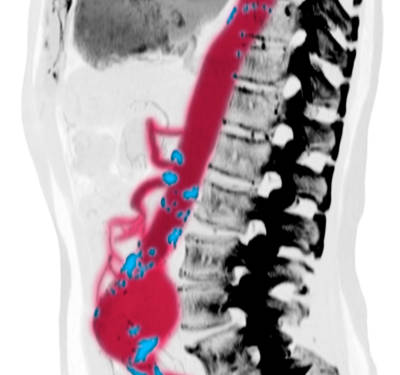Aneurysm screening in the emergency room could save lives
Abdominal ultrasounds on certain patients admitted to the emergency room may reveal life-threatening widening of the aorta.
Published online 31 January 2016

CT scan images showing an abdominal aortic aneurysmز
© Scott Camazine / Alamy Stock Photo
Practitioners at Beaumont Hospital in the United States conducted abdominal ultrasounds on 109 high-risk patients admitted to the emergency room over a ten-month period. Among the 90 patients whose ultrasound images qualified for the study, 8.9% were found to have abdominal aortic aneurysms.
An aortic aneurysms is a widening, larger than three centimetres, in the body’s main oxygenating artery as it passes through the abdominal cavity. It often goes undetected until it ruptures, causing almost-sudden death. Death can be prevented if the aneurysm is detected early through screenings, says Laura Oritz, one of the co-authors of the study published in the Journal of Emergency Medicine Trauma & Acute Care1.
Patients chosen for ultrasound screening in the study presented to the emergency department with symptoms of sudden reduced blood flow to the heart including chest pain, shortness of breath and temporary loss of consciousness. They were also Caucasian, male, over 50 and had a history of smoking, representing a high-risk group for abdominal aortic aneurysm.
“The emergency department serves almost as a primary care centre for a lot of patient populations,” says Oritz. Almost 80% of adults who visit the emergency department do so because they are uninsured and lack access to other options, according to estimates from a 2011 US National Health Interview Survey.
The emergency department could fill an important screening gap for asymptomatic abdominal aortic aneurysm in high-risk patients, especially since ultrasound is readily available in many emergency departments, emergency doctors are well trained in its use, and it is not time consuming, the team say.
The prevalence of abdominal aortic aneurysm is about 1 to 2% in the general population. The study indicates an apparent higher prevalence of the condition among older male patients with a history of smoking who present to the emergency department with symptoms of heart attack. This makes this group ideal for potentially life-saving screening for abdominal aortic aneurysms, the team reports. Oritz recommends follow-up studies showing the efficacy of screening patients for the condition.Reference
- Diffenderfer, L. E., Shah, P. & Bahl, A. Abdominal aortic aneurysm screening for high-risk cardiac patients in the emergency department. J. Emerg. Med. Trauma Acute Care2015, 2 (2015). | article
DOI: 10.1038/qsh.2016.97

